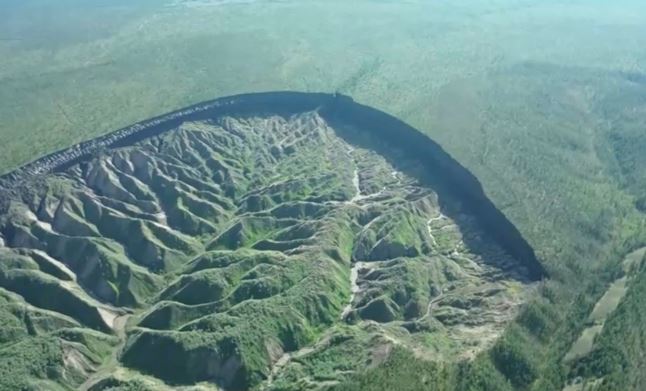Russia’s Batagaika Crater Expands Rapidly Due to Thaw
The Batagaika Crater, also spelled as Batagay, often referred to as the “gateway to the underworld,” is in the permafrost regions of Siberia, Russia and is known for its significant size and rapid expansion. Recent studies have shown that the crater is growing at an alarming rate of 35 million cubic feet every year due to the thawing of the permafrost.
Discovery and Initial Studies
Originally identified in 1991 via satellite imagery, the Batagaika Crater was formed after a section of hillside in the Yana Uplands of northern Yakutia, Russia, collapsed. This event revealed ancient permafrost layers that have been frozen for as long as 650,000 years, making it the oldest known permafrost in Siberia and the second oldest globally.
Causes of Expansion
The collapse of the hillside not only exposed these ancient icy layers but also initiated a continuous process of melting and sinking, primarily driven by global temperature rises impacting permafrost areas. The permafrost thaw rate around the crater’s cliff face is currently estimated at approximately 40 feet (12 metres) per year, contributing to the increasing size of this geological feature.
Impact of the Crater’s Growth
The dimensions of the Batagaika Crater have shown significant changes over recent years. In 2014, the width was recorded at 2,600 feet (790 m), and by 2023, it had expanded to 3,250 feet (990 m). This rapid expansion has resulted in vast amounts of ice and sediment, equivalent to over 14 Great Pyramids of Giza, being lost since the initial collapse event.
Significance and Future Research
The Batagaika Crater offers critical insights into the effects of climate change on permafrost regions and serves as a natural laboratory for studying ancient geological and environmental conditions. Ongoing research aims to continue monitoring the rate of expansion and its broader implications for the Arctic and sub-Arctic regions, highlighting the urgent necessity for global environmental strategies.
About permafrost
Permafrost refers to ground, including soil, rock or sediment, that remains completely frozen for two or more consecutive years. It is primarily found in high latitude regions of the Earth, such as the Arctic, and also at high elevations in mountains. Permafrost covers about 15% of the Northern Hemisphere. The thickness of permafrost can vary from less than a meter beneath the surface to over a thousand meters. It plays an important role in the Earth’s climate as it stores vast amounts of carbon dioxide and methane, which can be released as it thaws, thus impacting global temperatures. As global temperatures rise, permafrost is increasingly at risk of thawing, which can lead to the release of these greenhouse gases and result in significant ecological and geological changes, including the destabilization of buildings and other structures in Arctic communities.
About Yana Uplands
The Yana Uplands, located in the northeastern part of Siberia, Russia, is a rugged and remote plateau region situated around and along the Yana River. This area is characterized by its harsh Arctic climate, sparse vegetation, and permafrost. The uplands consist mainly of barren, rocky terrain, with elevation ranging up to 2,000 meters. It is a significant geographical feature due to its isolation and the ancient rock formations that contribute insights into the geological history of the Earth. The area is sparsely populated, primarily by indigenous Yakut people who engage in reindeer herding and other traditional activities. The Yana Uplands are also noted for yielding important paleontological discoveries, including prehistoric fauna fossils and evidence of ancient human presence in Arctic Siberia.
Month: Current Affairs - May, 2024
Category: Environment Current Affairs


